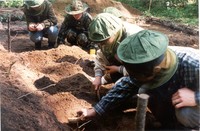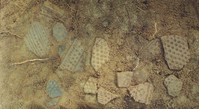Studies carried out in the south of Zaonezhie before 1997
 @kizhi
@kizhi



The first information about archaeological antiquities in the south of Zaonezhie refers to the late 19th — early 20th centuries. In particular, a slate axe has been found in the neighborhoods of the village of Sennaya Guba, fragments of hand axes are from the village of Koselga, a fragment of a slate pickaxe is from the village of Selga and a cross-shaped stone axe is from the village of Telyatnikovo.
The discovery of the Oleneostrovskiy burial ground in 1936 on the island of Juzhny Oleniy, located 7 km of Kizhi Island in Lake Onega, has become an important landmark in archaeological studies of Kizhi district. In 1936–1937 the burial ground was investigated by the expedition of the Institute for the History of Material Culture of the Academy of Sciences of the USSR under the guidance of V. I. Ravdonikas (164 interments were discovered). In 1946 the works were continued by A. J. Bryusov and in 1953, 1954, 1956 they were completed by N. N. Gurina.It is considered that in the process of excavation the site was fully depleted. The research results were summarized in the monograph of N. N. Gurina (1956). “Juzhny Oleniy Island” site was discovered on the same island in the course of the burial ground research conducted in 1938 by N. N. Chernyaguin. The site is also dated from the Mesolithic era. Later it was investigated by N. N. Gurina (1953), G. A. Pankrushev (1956, 1957) and V. F. Filatova (1972). The results were published in the monograph of G. A. Pankrushev in 1978.
In 1953 N. N. Gurina discovered a ruined site of the Stone Age in the neighborhoods of the village of Konda on Bolshoy Klimenetsky Island.
In 1955 G. A. Pankrushev conducted an archaeological reconnaissance in Zaonezhie. He has organized archaeological expeditions to Kizhi Island and to some ruined monuments of the Neolithic and the Middle Ages located in Sennaya Guba district.
In 1962 M. Aleshkovsky conducted archaeological explorations on the Island of Kizhi. He put down prospecting shafts by the fence of the Pogost. The shafts did not reveal any clear cultural layer and provided no finds.
In 1972 V. F. Filatova discovered a Neolithic site on Severny Oleniy Island in Lake Onega. Later, in 1991, the site was investigated by N. V. Lobanova.
In 1980 A. Spiridonov and V. Ushiskas conducted an archaeological reconnaissance on the Island of Kizhi. They put down a prospecting shaft on the Naryina Mountain in the central part of the island that was supposed to be the original location of the churches.It provided no finds. Nor any finds contained the shaft situated on the territory of the Kizhi Pogost, at the place where a foundation of a church could be visually observed. Presumably, it was the location of the ancient church burnt in the end of the 17 th century. According to the documents that were revealed later, this foundation could be dated back to the end of the 18 th century. In 1991 N. V. Lobanova and A. M. Spiridonov conducted an archaeological reconnaissance in the protected zone of the Kizhi museum. A. M. Spiridonov discovered four ancient settlements of the Middle Ages: the Kizhi Pogost, Navolok, Guivesnavolok and Vasilievo.
Two localities of flint fragments with traces of processing (Jamka 1 and Jamka 2) were discovered by A. P. Zhuravlev in 1992 on the Island of Kizhi. The localities are presumably dated from the Stone Age.
In 1996 A. M. Spiridonov found a fragment of a bronze spiral brooch with a triangular cross-section of the bow, which, according to Novgorod analogues, could be dated from the 10–11 centuries. The fragment of the brooch was found in the garden near the house of Jakovlev on the island of Kizhi.
In 1996–1997, as a result of a survey of the Sennaya Guba area, members of the archaeological sector of Karelian Research Centre of the Russian Academy of Sciences S. I. Kochurkina and T. P. Dmitrieva found ten localities of medieval ceramics, along with that, fragments of stucco early medieval ceramics of the 9–10 centuries were found in the garden of A. N. Medvedev.
